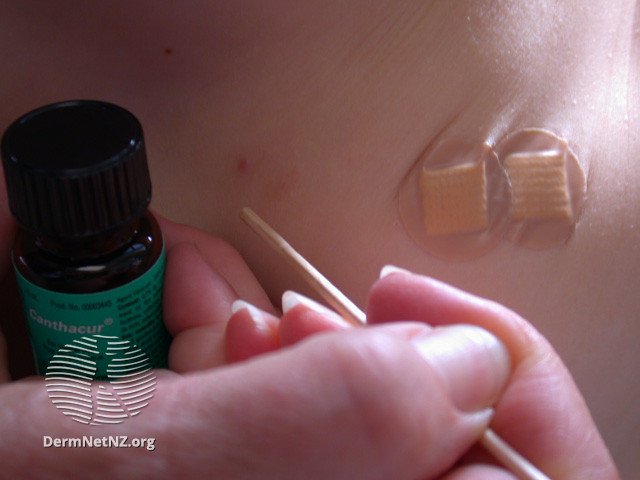
Cantharidin Application
Cantharidin being applied with a small cotton tipped-applicator before bandaging the area.
Credit: DermNet NZ
Introduction to Cantharidin Treatment
Cantharidin, colloquially known as "Beetlejuice," is a topical solution derived from the blister beetle. It is primarily used by dermatologists to treat viral skin infections such as warts or molluscum contagiosum. The medication induces a controlled blistering of the skin, aiming to lift and remove the infected tissue as the blister heals.
How Cantharidin Works
Upon application, Cantharidin causes the skin to form a blister. This is a water-filled blister that may feel like the discomfort of a blister from a new shoe or excessive friction. As this blister naturally dries and peels away, the hope is that the infected skin will peel away with it.
Application and Duration
Timely Removal: It's imperative not to leave Cantharidin on the skin for an extended period. The goal is a small, controlled blister. Overexposure can lead to larger, more uncomfortable blisters.
Reminder: Set a reminder or alarm for 3 hours post-application to wash off the Cantharidin. If no blister forms by then, especially on thicker skin areas like the soles, you can leave it a little longer. However, the medication should never remain on the skin for more than 6 hours.
Post-Treatment Care
Blister Care: Once the blister forms, it will take around a week to heal. While you can bandage the blister for comfort, it isn't a necessity. It's crucial to let the blister break naturally and avoid deliberately popping it.
Moisturizing: Application of Vaseline or Aquaphor can help soothe the treated area.
Other Treatments: If you're using other treatments, such as WartPeel or Dr. Scholl's, ensure the Cantharidin-treated area is fully healed before application. This might mean a waiting period post-Cantharidin treatment.
The effectiveness of the treatment can vary, and while some patients might find success after a single application, others might require multiple treatments. On average, warts usually need between 1-6 treatments for complete resolution.
Conclusion
Cantharidin offers a targeted approach to treating certain skin conditions. While it's effective, it's crucial to follow the guidelines for application and post-treatment care meticulously. Always refer to specific instructions provided by your healthcare provider or the Cantharidin instruction sheet to ensure optimal results and minimize discomfort.
